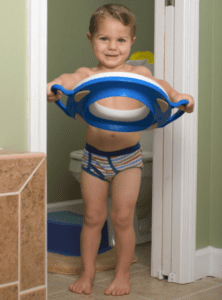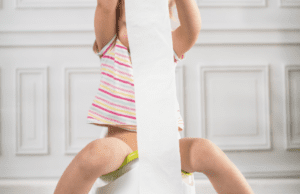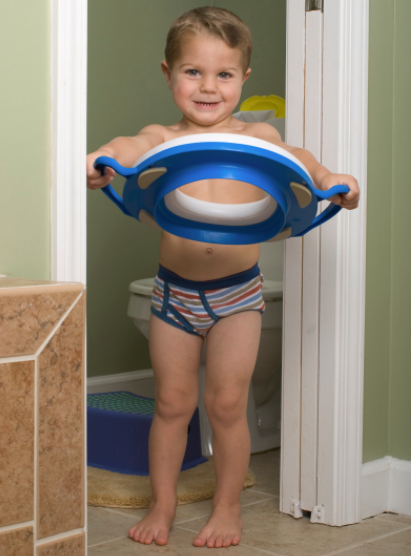Putting the PT in Potty Training
Putting the PT (Physical Therapist) in PT (Potty Training)
There are many physiological things that need to happen before a child is ready for potty training, such as awareness and the ability to hold/void voluntarily. They will also need higher level fine motor and sensory skills. Here are some of the factors involving the gross motor skills such as strength, balance, and coordination needed to ensure your child is physically ready to navigate this time.
To start, let’s break it down, step by step:
Step 1: Getting to the Bathroom in a Timely Manner
Once your child is aware of their need to void, they will have to be mobile enough to get into the bathroom on their own.
- – Can they traverse over the surfaces needed to get to the bathroom (tile, carpet, hardwood floor, steps, step over thresholds etc.)?
- – Are they able to open and close the door on their own?
- – Is there a light switch that they need to activate?
- – Is their balance good enough to reach overhead to do so?
Step 2: Removing Clothes
There may be obstacles keeping your child from getting to the restroom but once they have made it the next big obstacle is the clothing they have on. Zippers, buttons, belts, etc. all serve as barriers to hop over and hoops to jump through. Find what types of clothes work and what doesn’t for your child. Nothing is worse than a potentially successful trip to the toilet getting thwarted by difficult pair of clothes.

- – Once inside the bathroom, your child will then have to undress.
- – Are they able to remove lower body clothing without assistance?
- – This will require balance and coordination to remove their clothes without falling over
- – Do they have some higher-level fine motor skills to unfasten buttons, clips, or zippers?
Step 3: Sit Down
Once there are no barriers to voiding, your child will then need to get onto the toilet or potty seat. This may require a step stool if using an adult sized toilet.
- – Can your child step onto the stool without assistance?
- – Can they then turn around safely without assistance?
- – This incorporates not only strength, but balance, body control, and body awareness in space
- – If your child is using a small potty seat on the ground, they will have to control their movement enough to safely lower down to the seat
- – This incorporates eccentric strength and muscle control as well as balance to sit down slowly with control.
Step 4: Go Time
Once your child is on the toilet seat, they need to have sufficient balance to maintain that seated posture and allow for voiding.
- – It requires significant balance skills to balance on the toilet, especially if their feet are not on the floor!
- – Your child will need to coordinate breathing and relaxation to allow for relief of their urine or bowels.
Step 5: All Clean
Now that your child has voided, it is time to be sure they’ve sufficiently cleaned their bottoms.
- – Can they balance while on their potty or toilet to reach to get toilet paper?
- – This will require a weight shift from one side to the other while maintaining a seated position.
- – Do they enough movement and balance to lean or weight shift to one side to effectively wipe?
Step 6: The Dismount
All clean? Time to get off the toilet or potty seat.
- – Can your child stand up from a seated position on their own?
- – This requires strength, balance, and coordination; especially if they are on an oversized toilet without anything to hold onto
- – If they are on top of the step stool, they must now step down. This task challenges balance, body control, and eccentric strength.
Step 7: Getting Dressed
Now it is time to get our bottoms back on.
- – Can your child control their body while managing to pull up their underwear and pants?
Step 8: Handwashing
While not a part of the act of becoming potty trained, it is a valuable aspect of the larger motor plan of going to the bathroom independently. It requires another set of motor planning skills, balance and coordination to step up and reach the sink for hand washing. Remember, this also has to happen for at least 20 seconds!
Step 9: Potty Training Party!
Hooray! We’re ready to leave the bathroom.
Can your child open the door on their own? Sometimes the door will open inward which can be confusing for our little ones. This will require some backwards walking that relies on both balance, kinesthesia, and proprioception skills.
 Whew! Exhausted yet? You can really appreciate how hard these little bodies are working when you break it down step by step!
Whew! Exhausted yet? You can really appreciate how hard these little bodies are working when you break it down step by step!
Still have questions about all the skills required for potty training? Consult with one of our PT (physical therapy AND potty training) experts at Chicago Pediatric Therapy & Wellness Center today! Call 773-687-9241 for more information!


